-
Sikhism 1469
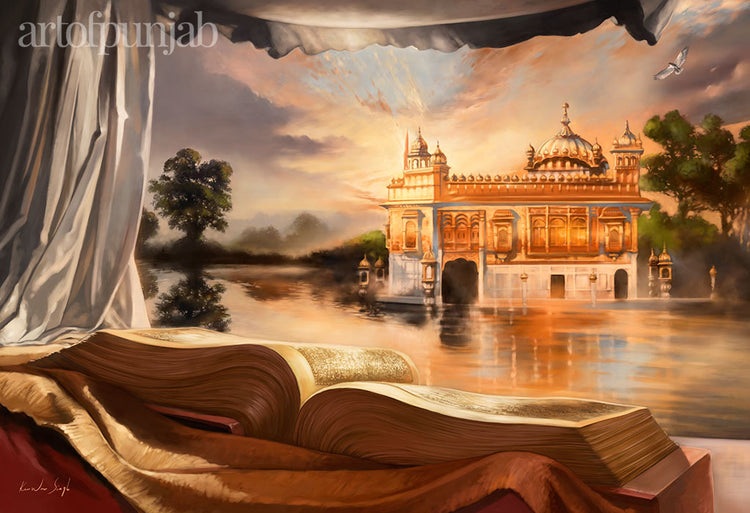
Siri Guru Granth Sahib - The Abode of Nanak
The Siri Guru Granth Sahib is the embodiment of the spiritual revolution which was first ignited by Guru Nanak dev ji and the life breath of eight more Nanaks nurtured and fed this flame. Then in 1699 Guru Gobind Singh ji, the tenth Sikh Guru, transformed that flame into a wildfire of spiritual liberation through the creation of the Khalsa panth.
We look to Siri Guru Granth Sahib as our guide to connect with the One internally, see the One in all and fight inequality and injustice in every sphere of our lives as the Gurus themselves did. The image of Harimandir Sahib (Golden Temple) reflects the other half of the spiritual revolution because it represents the innumerable gurudwaras and abodes of Nanak which we create to enable the sadh sangat to come together, remember Guru Nanak’s message and carry on his revolution.
-
1499
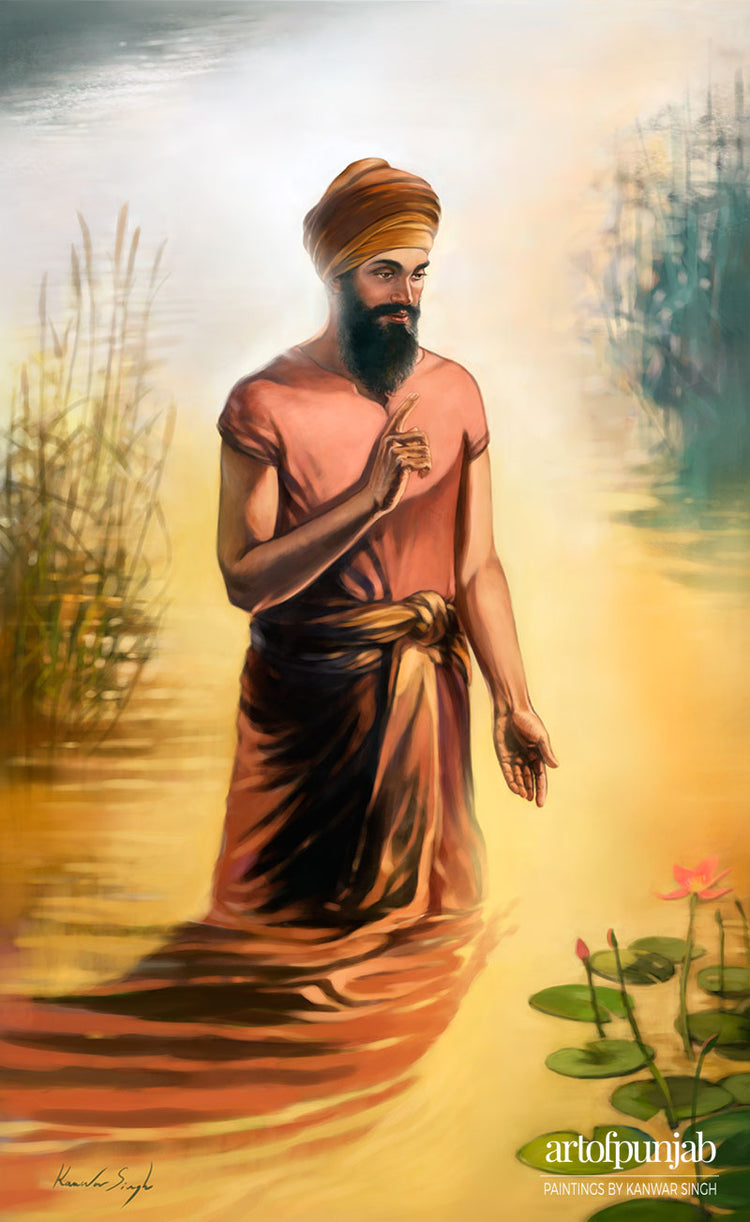
ੴ Ik Onkar
After leaving his birth village of Sabo ki Talwandi, Guru Nanak Sahib moved to Sultanpur Lodhi. It was here that one morning Guru Nanak Sahib disappeared into the dark waters of the Kali Bein rivulet. While in the water Guru Nanak had a deeply mystical experience with the Divine Creator. He was given his mission as Guru by the Divine and revealed some of the most important works of Sikh scripture including Japji Sahib, the foundational prayer of Sikhism. -
Second Guru 1504
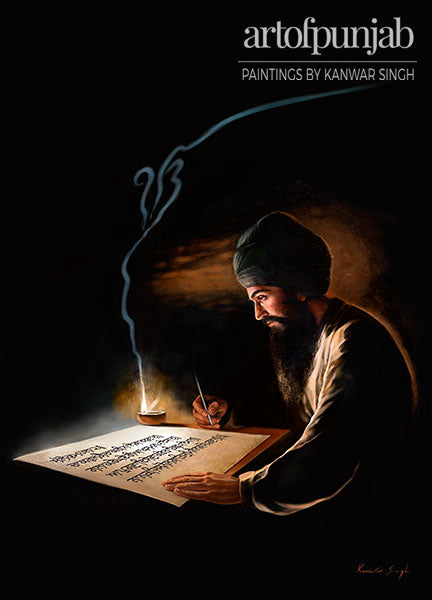
Guru Angad Dev Ji
Guru Angad Sahib the second in the line of Guru Nanak, prepares to write the Gurmukhi alphabet.Before he left his body, Guru Nanak Sahib passed on the Guruship of the Sikh Panth to Bhai Lehna. Lehna, through a series of tests, had proven his worth as the successor to Guru Nanak. Guru Nanak gave a new name to Lehna, naming him Guru Angad Sahib. Angad means “of my body”. Guru Nanak Sahib wanted the Sikh Panth to understand that though the Guru has changed his body, the light of the Shabad, the Divine light of the Guru, was the same. Guru Angad Sahib was simply the new Nanak. As the new Nanak, Guru Angad Sahib continued the work of his mentor. Guru Nanak had built a strong foundation, and Guru Angad developed the Sikh Panth from that base. Primarily, Guru Angad is remembered for is his refinement and standardization of the Gurmukhi script. This is the script of the Sikhs and is one of the two standards alphabets used for the Punjabi language today.
-
Third Guru
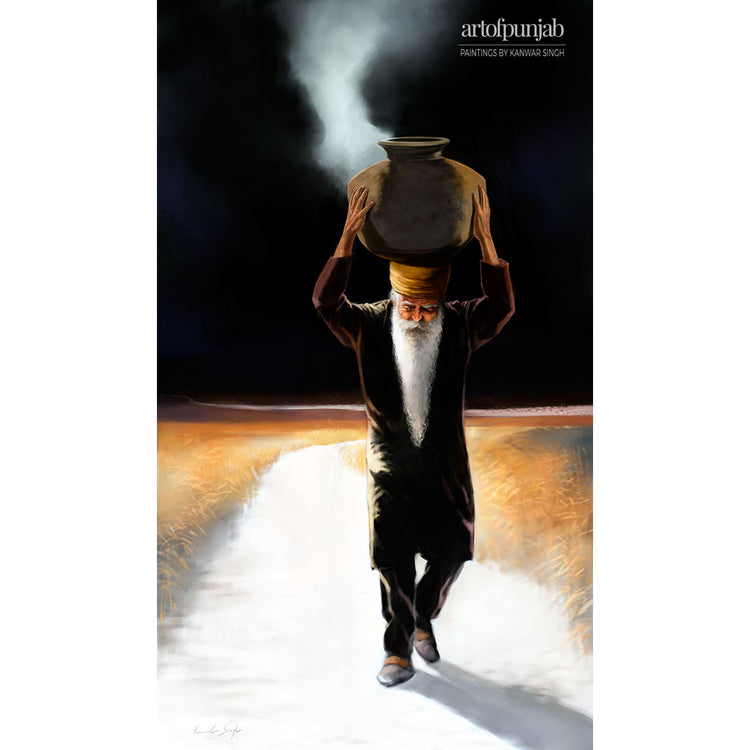
Guru Amar Das Ji
Guru Amar Das ji the third in the line of Guru Nanak. Though he was an old man when he encountered the Guru, casting aside the burdens of age, Guru Amar Das Sahib dedicated the latter years of his life to the Sikh Panth. He spent most of his time in service in the free kitchen, or Langar, of Guru Angad Sahib. He did this service without expectation of reward. After twelve years, when he was 72 years old, Guru Angad Sahib chose him as the next Guru, the next to carry the light of Nanak. Guru Amar Das Sahib is famous for having built the bustling town of Goindwal Sahib and for organizing and centralizing the Sikh Panth. He divided the Panth into 22 sections and appointed a Sikh to head each one. A champion of gender equity, Guru Amar Das Sahib appointed women alongside men in these administrative positions. -
Fourth Guru
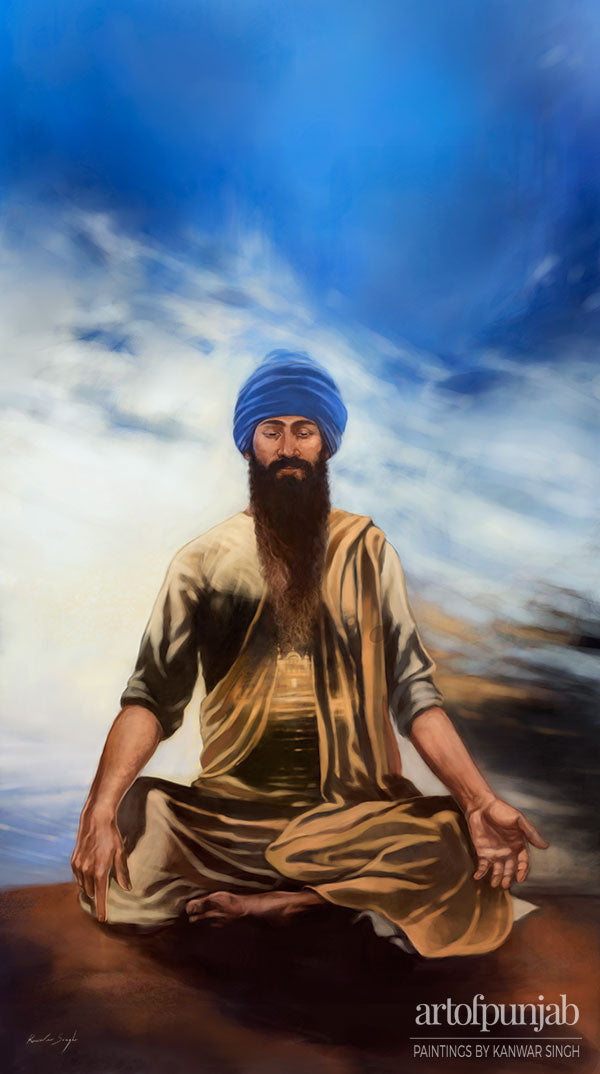
Guru Ram Das Ji
Guru Ram Das Sahib the fourth in the line of Guru Nanak, came from humble beginnings. He was born Bhai Jetha, and was an orphan who sold food on the street as a child to make ends meet. As a young man he met Guru Amar Das and began to live with the Guru. He quickly became famous in the Sikh Panth for his kind and loving attitude and his devotion to selfless service. Guru Amar Das Sahib’s daughter, Bibi Bhani, was married to Bhai Jetha. The two were sent by Guru Amar Das Sahib to start the new city of Amritsar. Later, the Guruship was passed to Bhai Jetha, who was given the name Guru Ram Das. Amritsar was open to all, where anyone, regardless of caste or background, could start a new life. The city was built around a Sarovar called Amritsar; a pool of water that Guru Ram Das had built. It was within this pool that the next Guru would build the heart of the Sikh Panth, Harmandir Sahib. -
Fifth Guru 1604
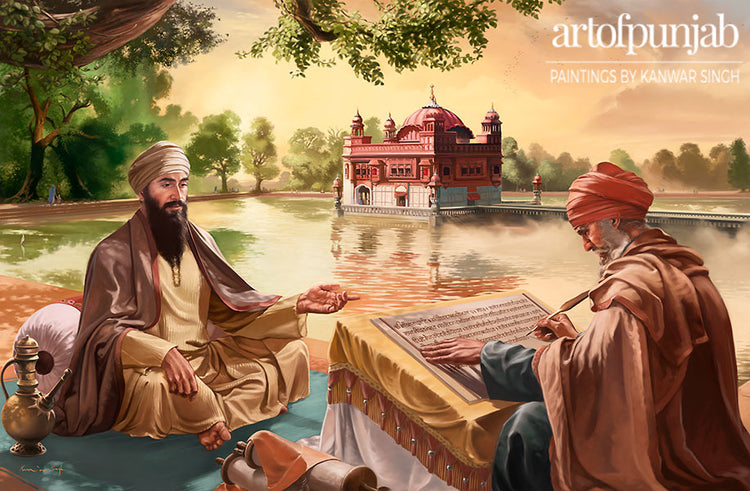
Guru Arjan Dev Ji - Birth of the Adi Granth
Guru Arjan Dev Ji, the fifth in the line of Guru Nanak, began the compilation of the Guru Granth Sahib, which he called the Adi Granth – the “primal knot” which would forever secure the sanctity of the Sikh faith. The Guru sent out a call to all Sikhs far and wide to bring forth the poetry composed by the four Gurus. When all the volumes had been collected, he sat down with his scribe Bhai Gurdas and carefully selected the genuine works into the Holy Granth. With the completion of this momentous work, the Guru gave the world a gift so pure and essential, that it could transcend the boundaries of time and religion and exist beyond personality and human form. -
Sixth Guru 1663
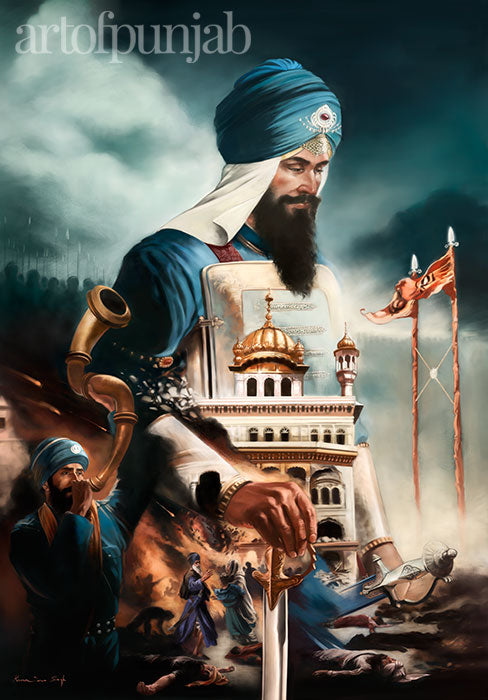
Guru Hargobind – Lord of Miri Piri
Guru Hargobind the sixth in the line of Guru Nanak, became the Guru of the Sikhs at the age of eleven after his father Guru Arjan was martyered on the orders of the mughal emperor. The Guru wore two swords representing Miri and Piri, to declare his temporal and spiritual authority. Guru Hargobind began construction of the Akal Takhat in 1663 with his own hands, and only Baba Buddha and Bhai Gurdas assisted him in this task. The Guru built the Akal Takhat to serve the panth for eternity and as the seat of the sovereignty of the Sikh nation it has withstood the assaults of many would-be rulers of the subcontinent who have come and gone. -
Seventh Guru 1644
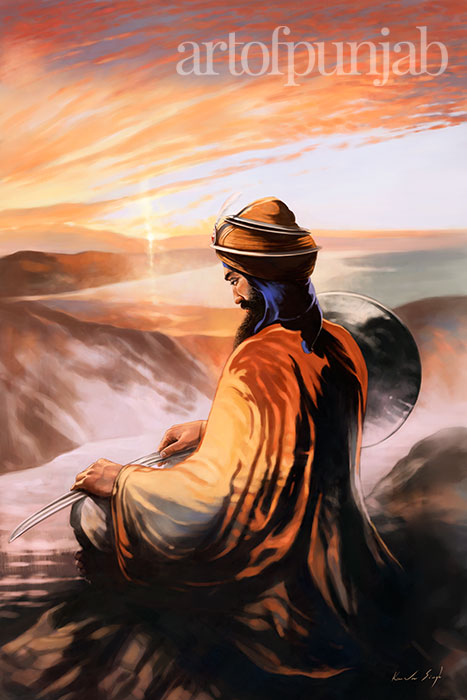
Guru Har Rai – Jyot The Divine Light
Guru Har Rai the seventh in the line of Guru Nanak, was the embodiment of gentleness and kindness. He respected the Jyot (Waheguru’s light) in every living creature and nurtured the health of even those who opposed the Sikhs. Through his actions, the Guru taught that doing Simran and entering the Tenth Gate (Dasam Dwaar) allows Waheguru’s light to be seen in everyone and every living thing, thus, eliminating the distinction between friend and foe. -
Eighth Guru 1661
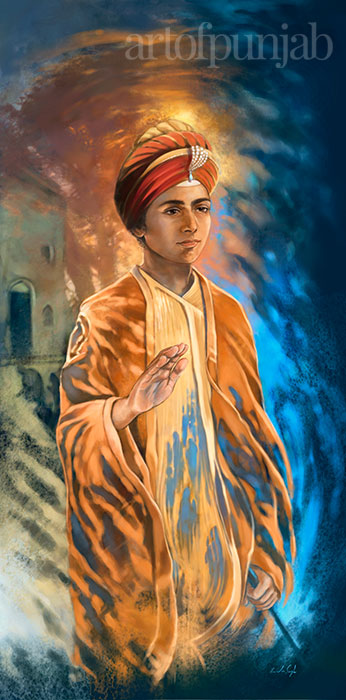
The Guru’s Grace – Sri Guru Har Krishan
Guru Har Krishan the eighth in the line of Guru Nanak, became Guru at the age of five. Despite the tenderness of his age, Guru Sahib continued the message of Shabad Guru to free humanity from the cycle of reincarnation. He demonstrated that regardless of age, anyone can become one with Waheguru through Simran. This painting of Guru Har Krishan Sahib is a meditation upon the words in our daily Ardas which ask us to reflect upon him. “Think of Guru Har Krishan, that sight dispels all sorrow.” -
Ninth Guru 1665
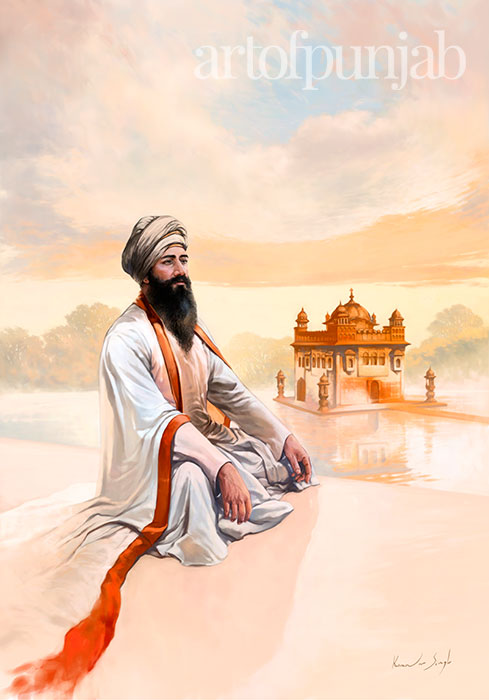
Guru Tegh Bahadur - The Protector
Guru Tegh Bahadur the ninth in the line of Guru Nanak, laid down his life in order to protect religious freedom for all of India which was under the oppressive rule of Mughal emperor Aurunzeb, who wished to convert the entire land to Islam. According to the Guru, living a truly spiritual life meant that one should neither oppress nor allow others to be oppressed. Sikh teachings have emphasized the basic human rights of equality, justice, freedom and the right to one's own religion. Under the inspiring guidance of Guru Tegh Bahadur, the Sikhs regained their confidence and continued to grow in numbers and resources. -
1699
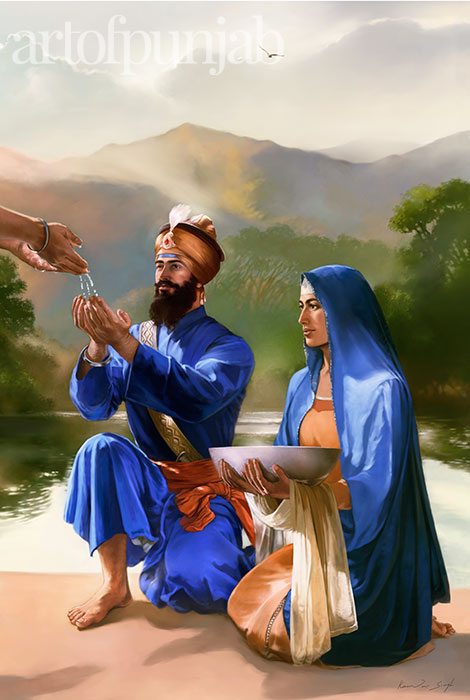
Guru Gobind Singh Maharaj
In a brilliant move of strategy and leadership, Guru Gobind Singh initiated the ceremony of Amrit and transformed the Sikhs into the fearless and united body of the Khalsa. The Khalsa became a brave and moral fighting force against the tyrannical Mughal ruler that occupied the Punjab. The Khalsa lives in the image and light of Guru Gobind Singh, dedicated to upholding righteousness, freedom, and the dignity of mankind. That is the Khalsa way. -
1708
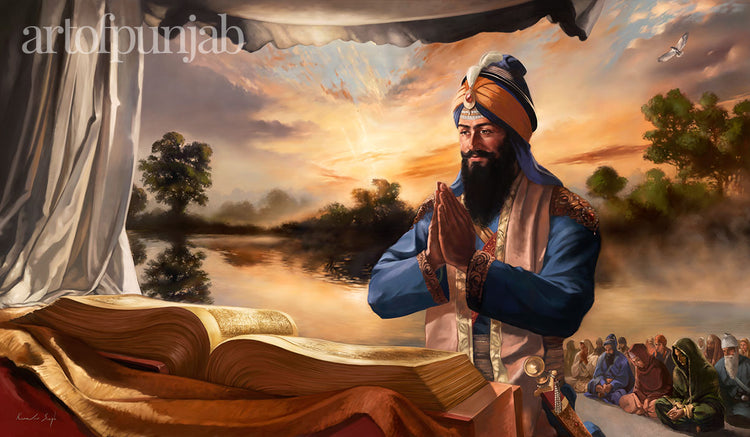
Gurgaddi Siri Guru Granth Sahib
Guru Gobind Singh ji passed the Guruship to the Guru Granth Sahib ji, our eternal Guru. The event was witnessed by a loyal retinue of Sikhs who had accompanied him south to Nanded. This closely knit sangat, said to be composed of roughly three hundred Khalsa soldiers including Mai Bhago, devout Sikhs and the few remaining members of the Guru’s own family, had endured much tragedy and hardship to remain by his side in those difficult times. In 1708, on the banks of the river Godavari, on a spot chosen by the Guru, they assembled and bore witness this sublime moment that defined Sikhism forever after. Guru Gobind Singh instructed them to follow the Guru Granth Sahib just as if it were a living, breathing Guru. -
1753
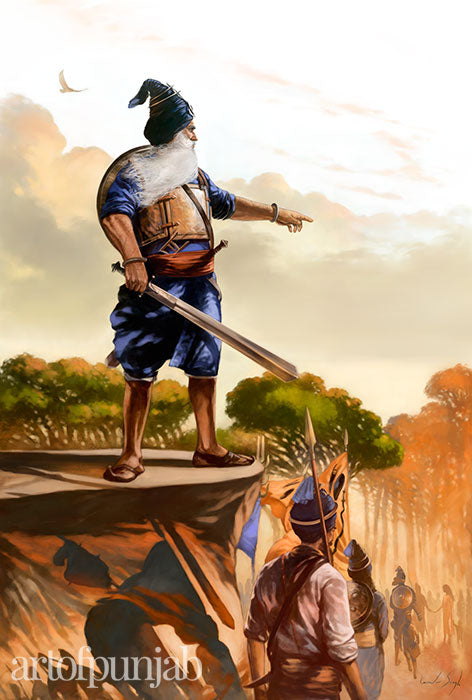
Baba Deep Singh Shaheed
1682-1753 Baba Deep drew a line with his Khanda and beseeched only those committed to giving their lives in defense of the Sikh faith to step over it. Five thousand Sikhs accompanied him on his journey to free Harimandir Sahib from the Afgan army that had desecrated it. Dressed as bridegrooms in fine clothing and festive ribbons, they joyously readied themselves to wed death. The painting speaks of this blessed journey and the mortal release experienced through their shaheedi spirit, where the spiritual fire upon which they cast their bodies also freed their souls. -
Battle of Chumkaur 1705
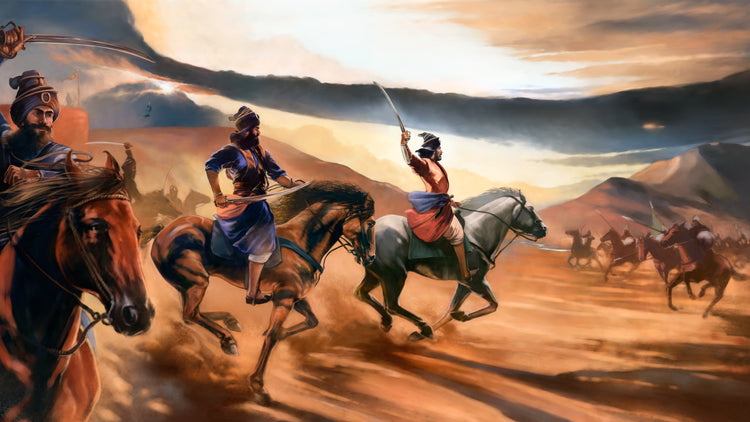
Baba Ajit Singh – The Khalsa Charge
In the prolonged siege of Anandpur in 1705, Sahibzada Ajit Singh displayed his qualities of courage and steadfastness. An unequal but grim battle commenced on 7 December 1704 in the words of Guru Gobind Singh's Zafarnama, a mere forty defying a hundred thousand. The besieged, after they had exhausted the meagre stock of ammunition and arrows, made sallies in batches of five each to engage the encircling host with sword and spear. Sahibzada Ajit Singh led one of the sallies and laid down his life fighting in the thick of the battle. He was 18 years old at the time of his supreme sacrifice for his faith. -
Battle of Chumkaur 1705
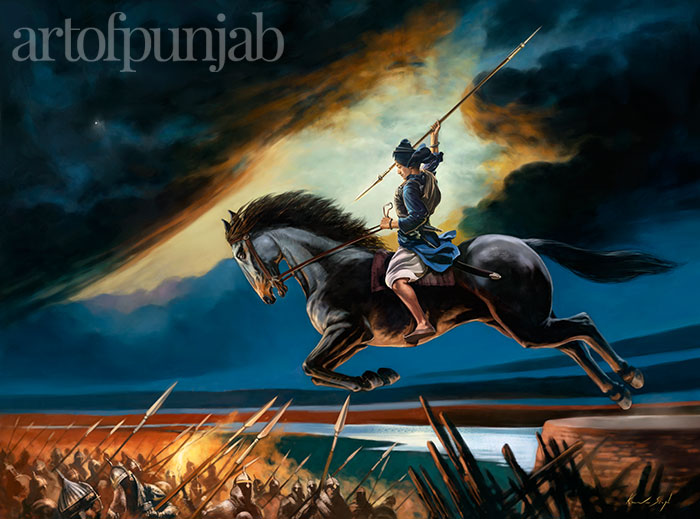
Baba Jujhar Singh
At the Battle of Chumkaur, Baba Jujhur Singh watched his brother Baba Ajit Singh attain Shaheedi. He desired to fight in the battlefield as well, though doing so meant certain death. He asked his father, Guru Gobind Singh, "Guru Sahib, permit me, dear father, to go where my brother has gone. Don't say that I am too young. I am your son. I am a Singh, a Lion, of yours. I shall prove worthy of you. I shall die fighting, with my face towards the enemy, with the Naam on my lips and the Guru in my heart." -
Battle of Anandpur 1700
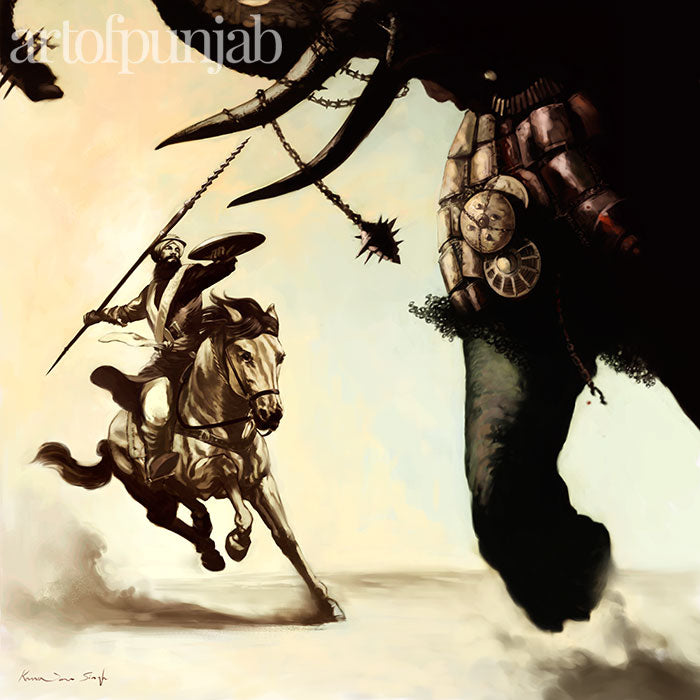
Bhai Bachittar Singh (Tonal) - Square
Initiated into the Khalsa on the historic first Vaisakhi Day, Bachittar Singh fought alongside Guru Gobind Singh in a number of battles in defense of Anandpur. This scene shows him in the famous single-handed combat with the enraged elephant charging at the Sikh fort of Lohgarh by the joint enemy forces of the Mughal Emperor Aurangzeb and the Hindu Hill Rajas. -
Vaisakhi 1699
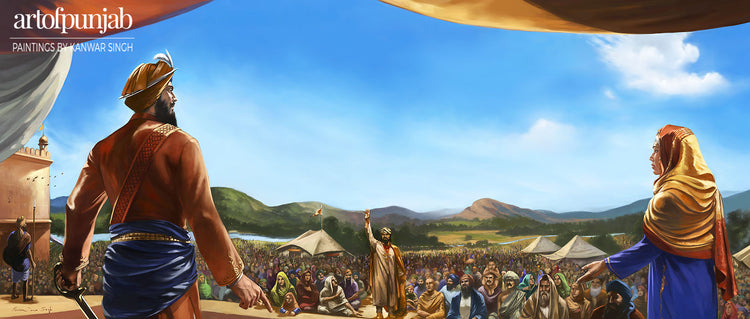
Vaisakhi 1699 Birth of the Khalsa
Bhai Daya Ram of Lahore, Punjab, is the first to raise his hand when Guru Gobind Rai asks for a volunteer willing to give his life in service of humanity. Mata Sahib Kaur looks on at the crowd of thousands that has gathered from across the land in response to the Gurus call. Transformed through Amrit into Daya Singh, he became one of the first 5 Khalsa, the Punj Pyaarey (the beloved five). -
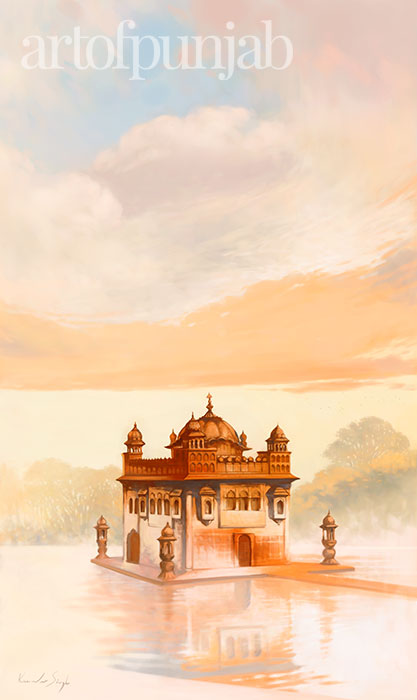
Pillar of Peace
The Harimandir Sahib is the heart of the Sikh Panth. It was conceived by Guru Ram Das ji when he built the sarovar on the site of a holy pool of water in the city of Amritsar, which he also founded. The next master, Guru Arjun completed the Harimandir sahib and installed the Adi Granth, the primal Sikh scriptures, within its walls. Harimandir sahib, in the time of the Gurus was not yet covered in gold but was already revered as the centre of Sikh spiritual life and the seat of the Gurus. Guru Hargobind would have looked across at its’ wondrous forms as he built the Akal Takhat to give Sikhs a place to settle all political and temporal affairs. Later Guru Teg Bahadur ji would sit upon the opposite edge of the sarovar and looked upon its’ four entrances with a pilgrim‘s longing when he was denied entry by the disloyal mahants. Nonetheless, the Sikh sangat of Amritsar still embraced their Guru within its’ view and today a small shrine marks that place on the sarovar in remembrance of their faith. Harimandir sahib has and will forever remain a vision of sanctity and peace within the hearts of every Sikh who lays eyes upon it. -
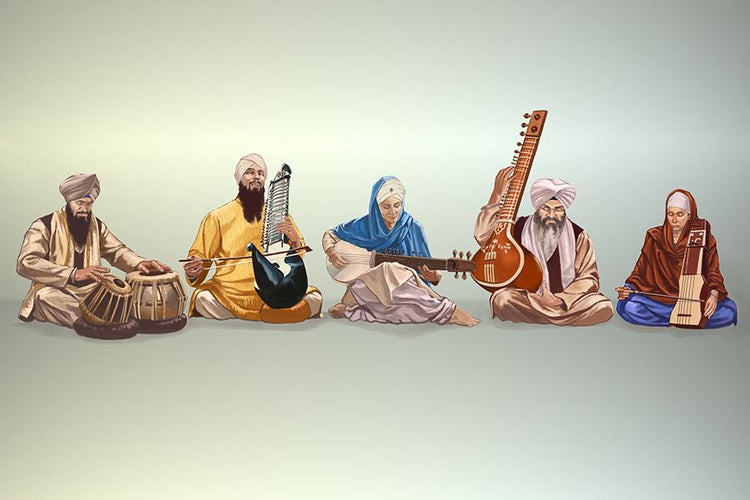
Kirtani Jatha
Kirtan is the devotional singing of praise as expressed in the hymns and compositions of Sikh scripture. Adoration expressed in song is considered by Sikhs to be the highest form of devotion, unsurpassed as the way to overcome the effect of ego and escape mortality. -
Battle of Muktsar 1705
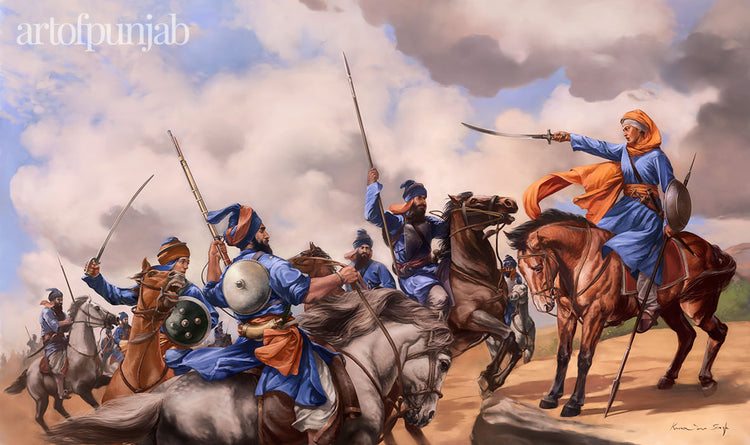
Mai Bhago and the Chaali Muktey
Mai Bhag Kaur (Mai Bhago) was the inspiration behind the bravery of the martyrs known as the Chaali Muktey (the Liberated Forty) who died in the 1705 Battle of Muktsar. When the siege went on for months, in hunger and despair, 40 Sikhs from Mai Bhago’s village of Jhabal lost heart and renounced their loyalty to the Guru in writing and deserted him. News of the betrayal quickly reached Jhabal and the ears of Mai Bhago. Boiling with rage, she went around the village and exhorted the women folk not to receive the deserters into their homes unless the made amends for the disgrace they had brought home with them. Mai Bhago rode out and intercepted the forty deserters as they neared the boundaries of the village. She challenged them to return to the service of the Guru and brought these men back to the path of devotion and sacrifice. -
1715
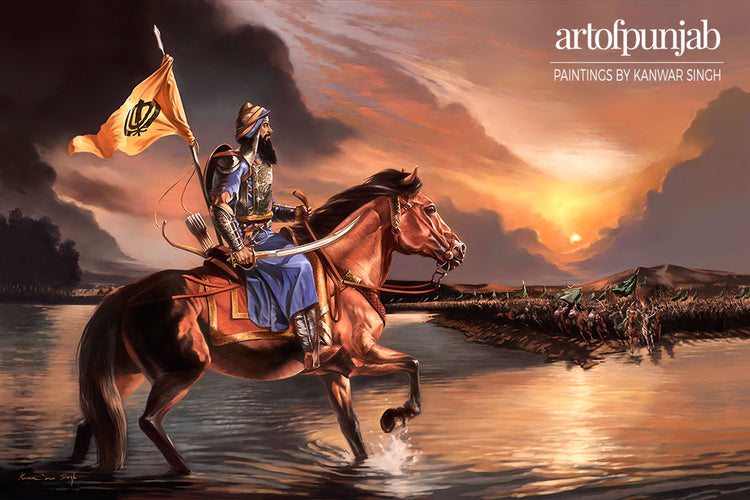
Banda Singh Bahadur - Sava Lakh Khalsa
Banda Singh Bahadur was handed the mantle of leadership from Guru Gobind Singh Ji himself. Born into the Hindu faith as Lachhman Dev, he encountered the Guru at Nander and immediately declared, “I am your Banda (slave).” Thus the Guru gave him the name Banda Singh Bahadur upon his initiation into the order of the Khalsa. After receiving the Guru’s blessing, Banda Bahadur became the first general of the Sikh panth. He amassed a force large enough to threaten the Mughal Empire and change the social, political and religious landscape of Punjab.“I will tell you, whenever men become so corrupt and wicked as to relinquish the path of equity and to abandon themselves to all kinds of excesses, then the Providence never fails to raise up a scourge like me to chastise a race so depraved; When the tyrants oppress their subjects to the limit, then God sends men like me on this earth to mete out his punishment to them.” – Banda Singh Bahadur
-
Vaisakhi 1699
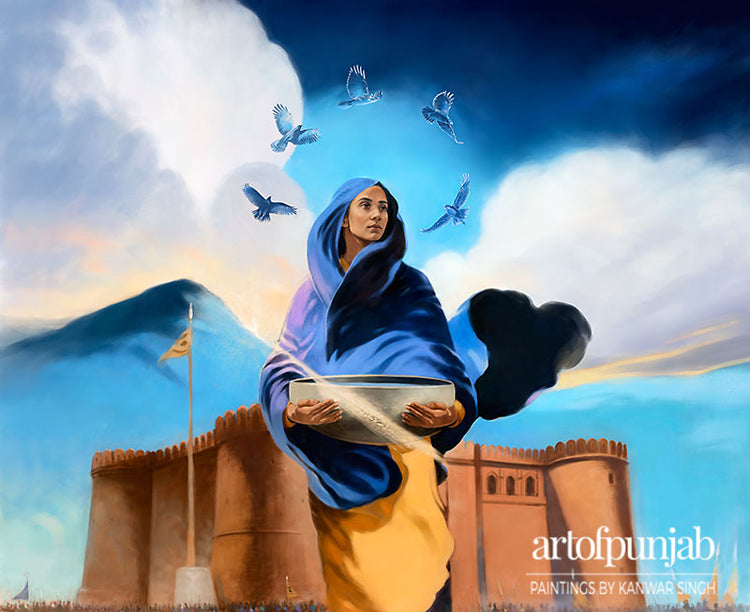
Mata Sahib Kaur - Mother of the Khalsa
Just as Guru Gobind Singh Sahib is considered the father of the Sikh nation, Mata Sahib Devan Kaur is considered its mother. A remarkable young woman, Mata Sahib Kaur was a born leader who took her role as symbolic mother of the Sikhs very seriously. When a Sikh takes Amrit from the 5 Beloved, they are born into the royal house of Nanak. To create an egalitarian society, all Sikhs consider Anandpur Sahib their birthplace and Mata Sahib Kaur their mother. -
1609 - present
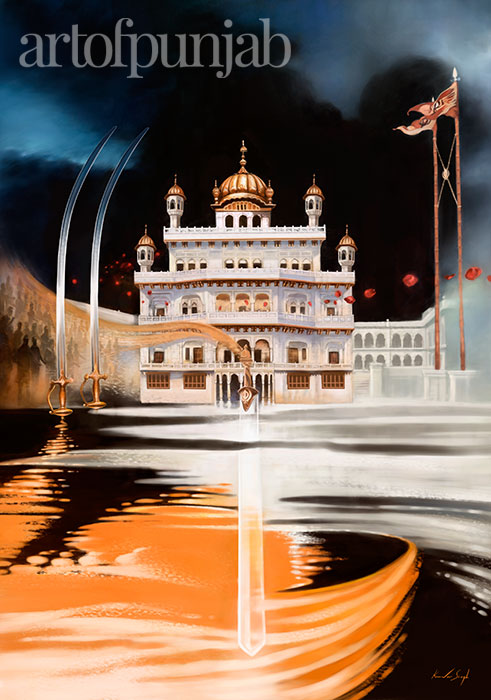
Sri Akal Takhat Sahib – Throne of the Almighty
This painting illustrates what Sri Akal Takhat sahib, the central legacy of Guru Hargobind sahib our sixth Guru, means to the Sikh quam. The artwork weaves the stories and imagery we relate to Guru Hargobind sahib, such as Bandhi Chhor and Miri Piri (spiritual and temporal balance) to capture the essential nature of our eternal bond to the Akal Takhat as central institution of Sikhism. In this painting, the visualization of blood transforming into flower petals is a reminder that liberation can be found through sacrifice, when the cause is just. Countless shaheeds throughout our history teach us, that with the grace of the Guru and the willingness to bow ones heads in sacrifice, a transformation in the very depths of our being can be experienced. This perfect union of Miri Piri, the inseparable connection between Sri Harimandir Sahib and Sri Akal Takhat sahib is shown in the painting as two interwoven energies. Within their merger we see the khanda and the bata which represents the formation of the Khalsa panth and creation of a new type of being, the saint soldier. -
Battle of Anandpur 1700
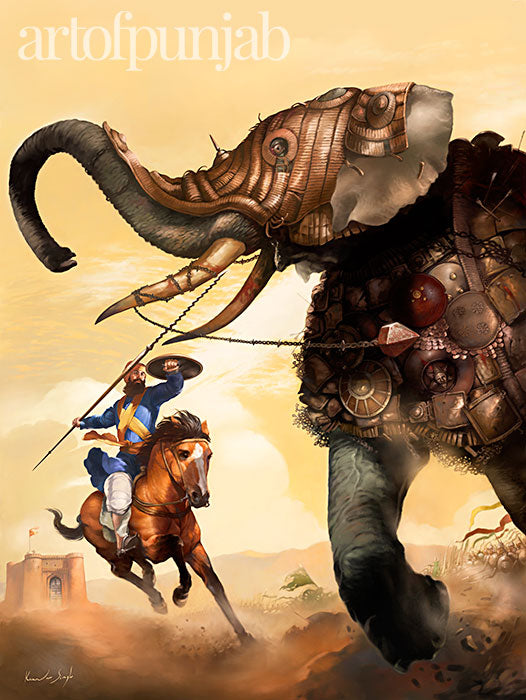
Bachittar Singh – Saint Soldier
Initiated into the Khalsa on the historic first Vaisakhi Day, Bachittar Singh fought alongside Guru Gobind Singh in a number of battles in defense of Anandpur. This scene shows him in the famous single-handed combat with the enraged elephant charging at the Sikh fort of Lohgarh by the joint enemy forces of the Mughal Emperor Aurangzeb and the Hindu Hill Rajas. The Guru gifted Bhai Bachittar with two essential things to defeat the enraged beast, the Nagni spear and the courage to use it. -
First World War
1914 - 1918
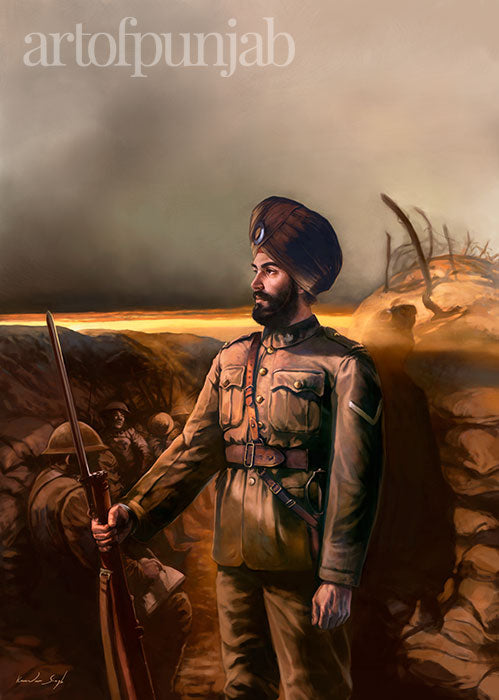
Stand on Guard for Thee
To commemorate the 100th Anniversary of Sikhs contribution to World War One, this painting represents a foray into the contemporary period of Sikh Military history. It deals with the role of Sikh men and women of various nationalities who lived through this epic confrontation of Nations. The title of the painting, taken from the Canadian National Anthem, reflects upon the willingness of Sikhs to fight against oppression throughout history. It is a testament to the spirit of Guru Gobind Singh, which forever emboldens the Khalsa to strive towards a greatness that surpasses humble beginnings. -
Battle of Anandpur 1700
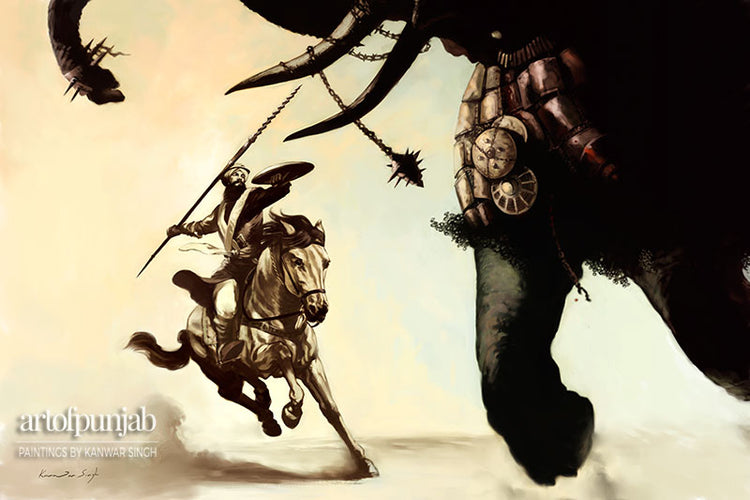
Bhai Bachittar Singh (Tonal) - Wide
Initiated into the Khalsa on the historic first Vaisakhi Day, Bachittar Singh fought alongside Guru Gobind Singh in a number of battles in defense of Anandpur. This scene shows him in the famous single-handed combat with the enraged elephant charging at the Sikh fort of Lohgarh by the joint enemy forces of the Mughal Emperor Aurangzeb and the Hindu Hill Rajas.


























